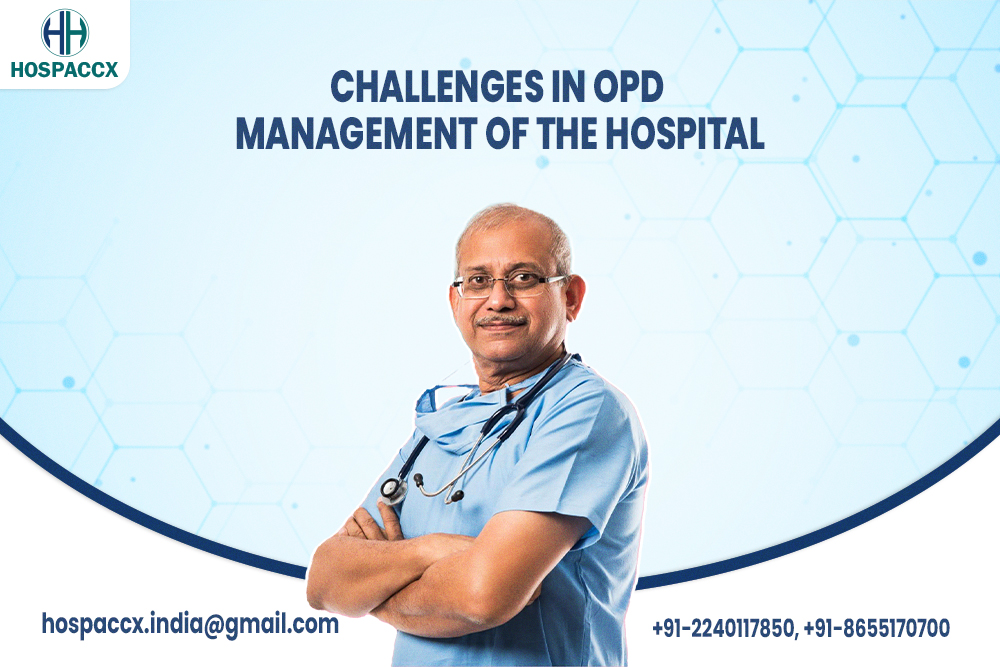CHALLENGES IN OPD MANAGEMENT OF THE HOSPITAL
Are you aware of common challenges related to OPD management? Are you facing any problem in OPD management of the Hospital? In this article, Hospaccx Healthcare Consultancy has listed the challenges faced in OPD Management of the Hospital.
INTRODUCTION
OPDs are described as the face of any hospital, as it is often one of the first points of contact between patients and the hospital. Out-Patient services are the most important service provided by the hospital as it provides services to a large number of patients at an affordable cost. The utilization of many of the other services provided by the hospital often depends on how satisfied the patient is with the outpatient services provided.
When well organized and professionally run, not only can such OPDs help avoid confusion, frustration, and overspending by fearful patients but can also regulate the flow of inpatients to the hospitals. The impression of a hospital’s OPD often influences the patients’ sensitivity towards the hospital. Therefore, it is essential to ensure that OPD services provide an excellent experience to the customers.
FUNCTIONS OF OPD
Indian healthcare facilities have been in doldrums concerning scarcity of management for OPD patients. And this has been the case for public and private hospitals alike. Some common function performed by the OPD’s are:
- Early diagnosis of any disease with modern techniques and for prophylactic examination.
- Provides Ambulatory and Domiciliary treatment to all cases
- Route for inpatient admission.
- Provides aftercare and medical rehabilitation if necessary, after discharge from the hospital and carry our health promotion activities.
- Trains medical, nursing, and paramedical personnel; maintains records and collects data for epidemiological and social research.
- Participates in various preventive activities such as – well-baby clinic – ante-natal clinic – school health program, health education, and nutrition advice – immunization – early reporting of communicable diseases.
SOME COMMON PROBLEMS FACED IN OPD MANAGEMENT OF HOSPITAL
With the increase in the outpatient volume and patient flow, there may be an increase in the blockages, which in turn creates a longer problem inefficient management of OPD’s.
- Non-responsive reception and apathetic staff.
- Wild search of specialty OPDs by patients.
- Appointment jumping.
- Long waiting hours at each point of contact.
- Non-availability of reports of various investigations.
- Inadequate time given for each patient.
- Poor rapport or communication between doctors and patients.
- Non-availability of equipment and supplies.
A developing country like India has far greater challenges for healthcare delivery; especially when the Public Health delivery system is yet to mature.
In a competitively managed healthcare environment, the long waiting time of patients in an OPD adversely affects the hospital’s ability to attract new increased business. It is difficult to sell services if individuals are dissatisfied with the delayed process and increased waiting time.
SOLUTIONS TO TACKLE THIS OPD MANAGEMENT PROBLEMS
- Appointment system in OPD to reduce the waiting time.
- 24 hrs. registration system to fix appointments for old cases and accommodating emergency cases as early as possible again to reduce waiting time.
- Filter clinics: Clinics on the ground floor with junior doctors so that minor ailments like cough, cold can be treated and sent back so that they do not overcrowd the specialty OPD.
- Starting the OPD in time to reduce the waiting time and prolonging OPD time with another shift of doctors to provide services to a maximum number of patients.
- Satellite Clinic: Community outreach clinics of the hospital will reduce the OPD load in the main hospital.
- Sufficient waiting area with adequate resources to cater to the load.
- Efficient department of hospital administration for day to day redressal of problems.
METHODS TO QUALIFY AND QUANTIFY THE PROBLEMS AND DESIGN ALTERNATE SOLUTION
- Direct Observation
- By direct observation, it is meant that one should observe the structural and process criteria in OPD.
- See whether the location of OPD is easily visible to the public, accessible, and conveniently placed for the patient.
- Site of OPD with its need
- Separate entrance without cris-crossing the inpatient services.
- Sharing of investigation facilities with inpatients.
- Unidirectional flow of patients.
- Liberal parking space.
- Space for future expansion.
- Evaluation of Process
- Flow Concept: The flow concept defines the patient load in the various areas of OPD. This would help to extend services accordingly.
- Holding capacity: Holding capacity is the adequacy of space to hold the patients in waiting areas. All OPDs with more than 2 floors should have lifts with adequate space.
- Activity Sampling: You have to assess the utilization pattern of man and material concerning workload by conducting an Activity Sampling.
- SWOT Analysis: The analysis of the Strength, Weakness, Opportunities, and Threats of a hospital is a must before analyzing the services in its OPD. This would help you in reviewing the policies and procedures of the service provided and seek the necessary solution.
- Queuing Theory: This is an operational research technique to quantify the waiting time of patients in each specialty and suggest an alternate solution to reduce the queue and waiting time.
- Systems Analysis: This is also an operational research technique in which you need to analyze the policies and procedures; qualify and quantify the service with several hospital beds.
At the end of this whole process, the management will be able to qualify and quantify the OPD service provided in any hospital. The analysis of this action plan will help in developing the alternate solutions and select the best course of action for the efficient management of the OPD services.
CONCLUSION
OPD is an ambulatory care centre that provides to all members of a community the whole scope of services that are needed to keep them in good state of health directly or by referral to more qualified institutions. As there are numerous technological advances in diagnostics, medications, procedures, and modifications in healthcare reimbursement plans, the model of healthcare has been gradually shifting away from the inpatient setting to an outpatient basis. Apart from the quality of staff, equipment’s the main feelings and image carried by patients about hospital mainly depends on the human aspect and the concern, sympathy, and understanding shown by hospital staff and this thing comes from the efficient management of the OPD services.
Are you looking for a consultant to advise you on efficient OPD management techniques? We can help you to tackle the challenges faced in OPD Management of your Hospital.
If you need any support, you can contact us: Hospaccx healthcare business consulting Pvt. Ltd Or you can visit our website hospaccxconsulting.com
Related Team Members




















